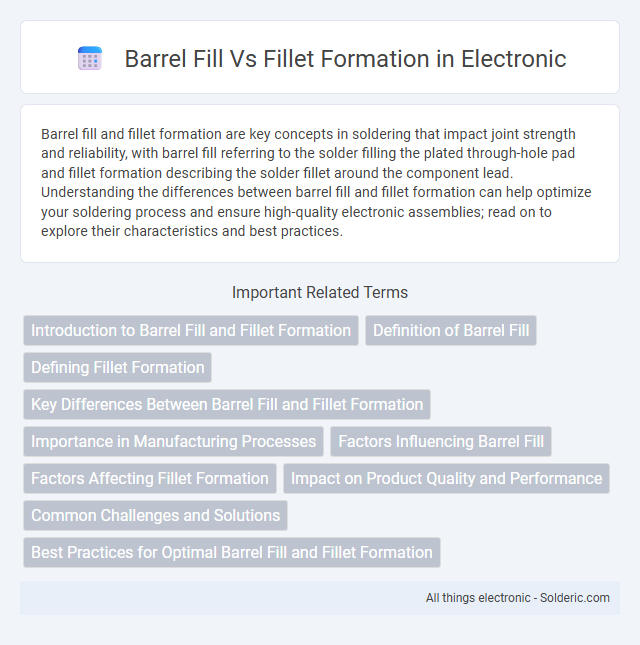Barrel fill and fillet formation are key concepts in soldering that impact joint strength and reliability, with barrel fill referring to the solder filling the plated through-hole pad and fillet formation describing the solder fillet around the component lead. Understanding the differences between barrel fill and fillet formation can help optimize your soldering process and ensure high-quality electronic assemblies; read on to explore their characteristics and best practices.
Comparison Table
| Aspect | Barrel Fill | Fillet Formation |
|---|---|---|
| Definition | Material accumulation causing a barrel-shaped deformation during filling | Rounded edge formed where two surfaces meet, typically to strengthen joints |
| Occurrence | Common in injection molding, casting, and additive manufacturing | Used in welding, soldering, and design for stress distribution |
| Cause | Uneven pressure or flow leads to bulging in the middle of the fill area | Intentional design feature or result of material smoothing |
| Effect | May cause defects, dimensional inaccuracies, or stress concentrations | Enhances strength, reduces sharp edges and stress risers |
| Appearance | Convex bulge resembling a barrel shape | Smooth, concave or convex rounded edge at material junction |
| Control Methods | Optimizing pressure, temperature, and flow during filling | Design incorporation via chamfering or adding radius in joints |
Introduction to Barrel Fill and Fillet Formation
Barrel fill refers to the volume of molten material that fills the interior of a joint during welding, ensuring a complete fusion between base metals. Fillet formation, on the other hand, involves creating a concave or convex reinforcement bead along the weld joint's edge to enhance strength and prevent cracks. Understanding the balance between barrel fill and fillet geometry is crucial for optimizing weld integrity and mechanical properties.
Definition of Barrel Fill
Barrel fill refers to the internal deposition of molten material during additive manufacturing or welding processes, where the central region within the deposited layer is fully filled, avoiding voids or incomplete fusion. This phenomenon ensures a uniform and dense microstructure that enhances mechanical properties and structural integrity. Understanding barrel fill is crucial to optimizing your fabrication parameters and achieving high-quality, defect-free builds.
Defining Fillet Formation
Fillet formation refers to the rounded interior corner created where two surfaces meet, enhancing joint strength and stress distribution in manufacturing and welding processes. Unlike barrel fill, which involves filling a cylindrical cavity, fillet formation ensures a smooth transition between perpendicular or angled parts, reducing the risk of cracks and improving durability. Understanding fillet formation helps you optimize structural integrity and achieve precise, reliable connections in your projects.
Key Differences Between Barrel Fill and Fillet Formation
Barrel fill refers to the internal deposition of molten material within a cavity, ensuring complete filling without voids, while fillet formation is concerned with the external bead or smooth curve at the junction of two surfaces, typically enhancing structural strength and aesthetics. Barrel fill emphasizes volume integrity and uniformity during the filling process, whereas fillet focuses on corner reinforcement and stress distribution. Understanding these distinctions is critical in manufacturing processes such as casting, welding, and additive manufacturing, where precise control over fill quality and joint strength determines product performance.
Importance in Manufacturing Processes
Barrel fill and fillet formation play critical roles in manufacturing processes by influencing the structural integrity and aesthetic quality of welded joints. Proper barrel fill ensures optimal material distribution and minimizes defects, while accurate fillet formation enhances joint strength and load-bearing capacity. Understanding these factors helps you achieve reliable, high-performance assemblies essential for industrial applications.
Factors Influencing Barrel Fill
Factors influencing barrel fill formation include extrusion speed, die geometry, and material flow behavior under pressure. Higher extrusion speeds often increase friction and temperature, promoting barrel-shaped deformation due to uneven velocity distribution. Die lip design and material viscosity also critically impact the extent of barrel fill during polymer processing.
Factors Affecting Fillet Formation
Factors affecting fillet formation include welding parameters such as heat input, welding speed, and torch angle, which determine the molten metal flow and cooling rate. Material properties like thermal conductivity and weldability influence the fusion between base metal and filler, impacting fillet size and strength. Joint design and fit-up quality also play a critical role in controlling fillet geometry and consistency during the welding process.
Impact on Product Quality and Performance
Barrel fill and fillet formation directly influence product quality and performance by affecting structural integrity and sealing effectiveness. Barrel fill ensures uniform distribution of materials, reducing defects like voids or weak spots, which enhances durability and overall reliability. Your product benefits from fillet formation by creating smooth, reinforced joints that improve stress resistance and prevent leakage, critical for maintaining performance under varying operational conditions.
Common Challenges and Solutions
Barrel fill and fillet formation often face challenges such as incomplete filling, voids, and inconsistent bead shapes due to improper temperature control or inadequate material flow. Ensuring precise temperature management and optimizing dispensing speed can significantly improve fill uniformity and fillet quality. You can achieve better joint strength and aesthetic results by selecting appropriate welding parameters and using real-time process monitoring to detect and correct defects early.
Best Practices for Optimal Barrel Fill and Fillet Formation
Achieving optimal barrel fill and fillet formation requires precise control over injection molding parameters such as melt temperature, injection speed, and pressure to ensure consistent material flow and minimize voids or weld lines. Utilizing high-quality polymer resins with appropriate flow characteristics and maintaining mold temperature within specified ranges enhance surface finish and mechanical strength of the fillets. Regular mold maintenance and cavity design optimization, including proper gate placement and draft angles, are essential to promote uniform fill and robust fillet geometry, reducing defects and improving overall part integrity.
Barrel fill vs fillet formation Infographic

 solderic.com
solderic.com